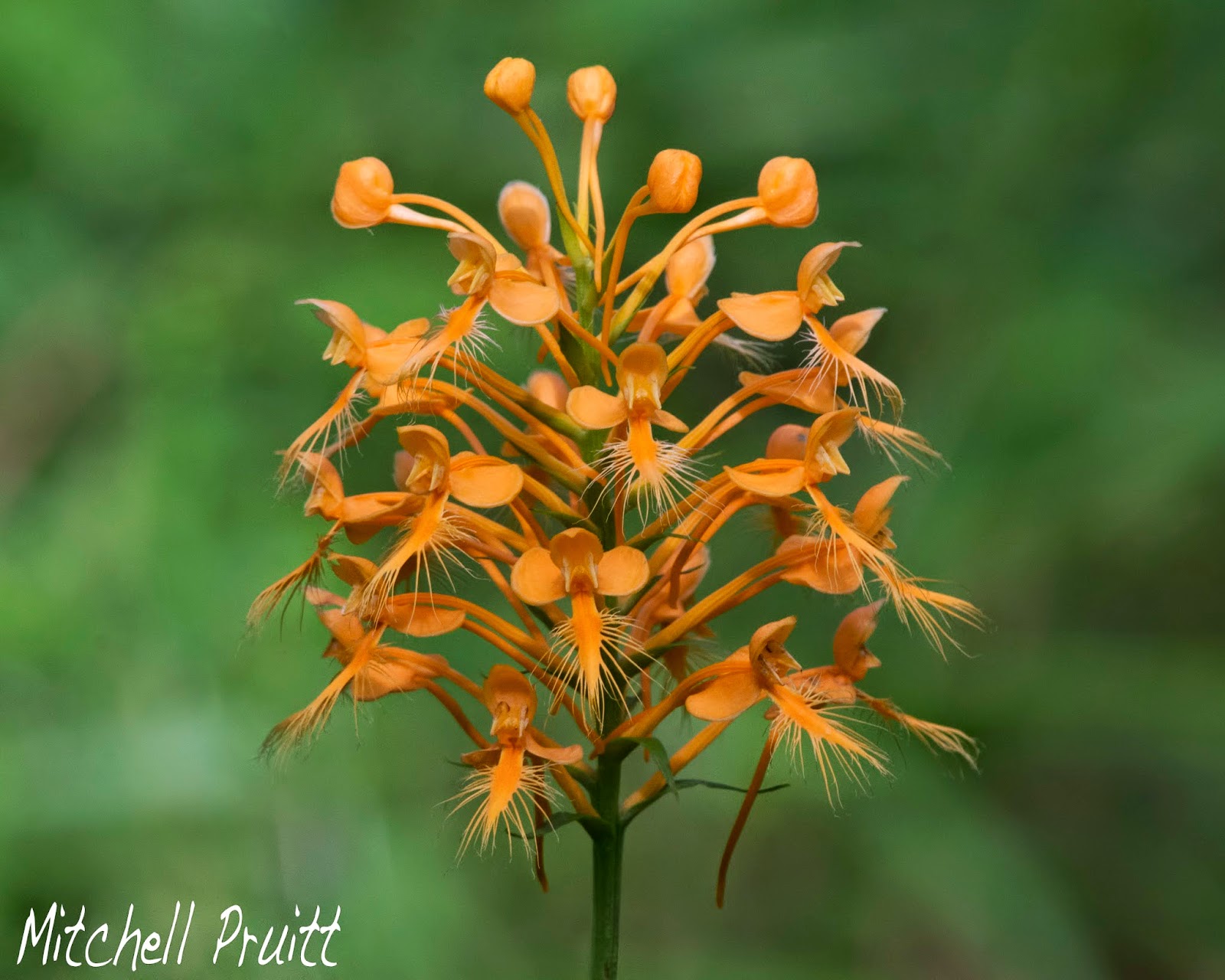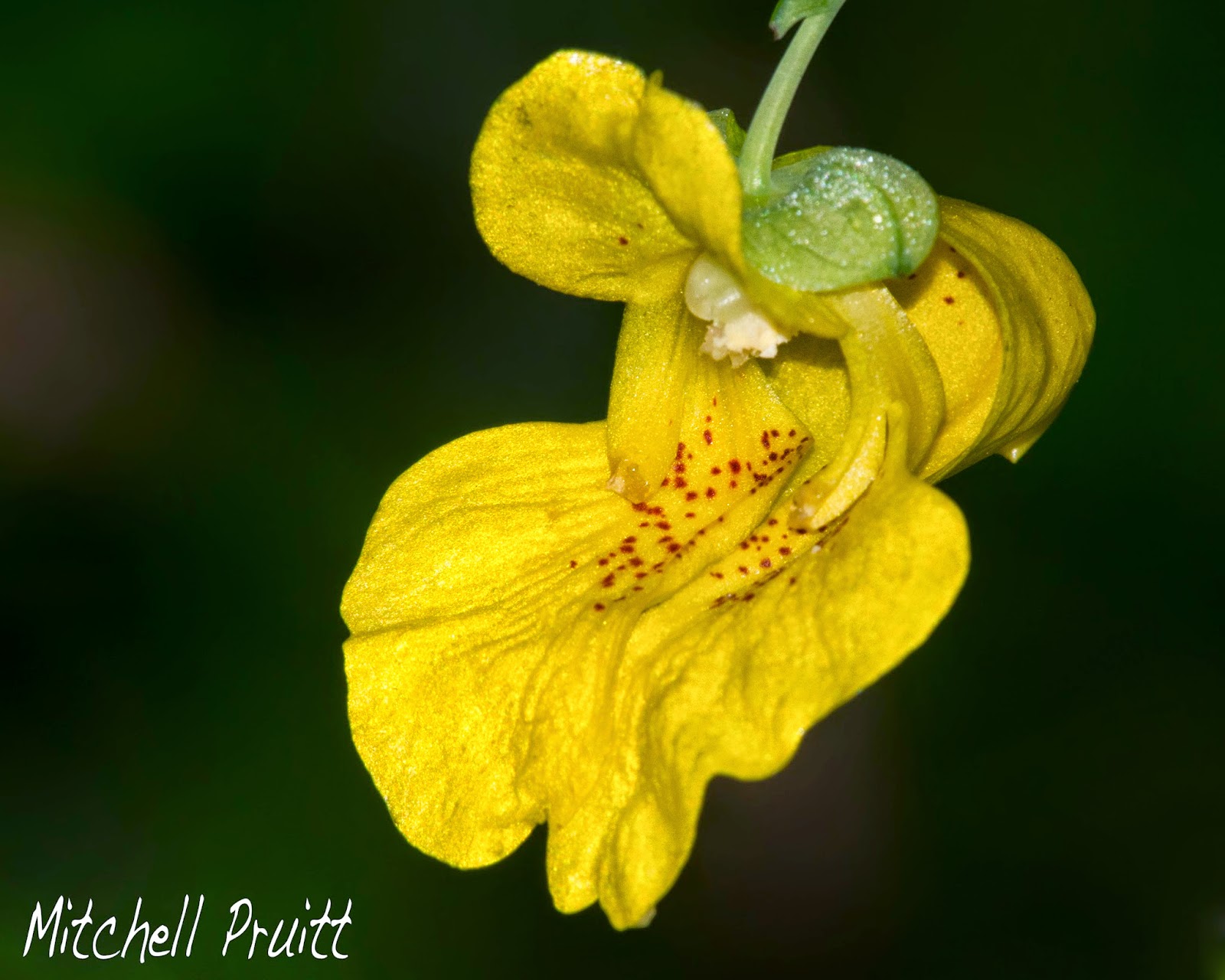Many who know me also know that I am not just a birder. It's true that's how it ALL got started, but birding was only the gateway (Only is a strong word, so I should note that birds continue to be my main forte). With birds came photography and with photography came an interest in most things nature, which can be a bit overwhelming at times. For me, I would say that second behind birding (and wildlife photography), falls wildflower photography. A lot can be learned about an ecosystem by the plants that are found there, even more so than the birds in many instances; and when a plant comes with a fancy flower, I'm all over it. Even the simple ones are nice for a change, too.
 |
| A fairly simple woodland sunflower oasis. Mt. Magazine State Park, AR. |
In Arkansas, the wildflower season kicks off in mid to late March with white trout lilies (E. albidum) ringing in the spring with their immaculately arched petals. Things really get going by mid-April and only get better through May, when the forest floor is a carpet of color. The rush slopes off after that and trickles through the middle of summer. Don't get me wrong, summer is when you can see some of Arkansas' most impressive blooms, but it's not quite as hot-and-heavy as it was weeks earlier. By the middle of August through much of September, the flowers pick up once more; just in time to say goodbye before the cold hits. To know the ins-and-outs of wildflowers, one must understand that it's all relative. Sometimes winter runs a little over and things are late, some years it's just the opposite. Spring 2014 was one of the years where things were behind…almost two weeks, but then we get one of those baking summers that puts things back in their proper order. And back in order they are. As I write, all those umpteen different species of goldenrods are blooming or getting ready to. Right on schedule. (As is the infamous ragweed, *cough, cough*).
 |
| Tall Green Milkweed (Asclepias hirtella) |
Hmm. Favorites of the season, you ask? Well, I'll start with the milkweeds, always a favorite group of mine. (The new atlas to Arkansas' vascular plants lists 16 species of milkweeds). New to me this year, and getting an easy one out of the way, is tall green milkweed. I've never met a milkweed I didn't like and this one standing at nearly 4' tall, with its green blooms and maroon accents, is no exception.
From there, I'll go to another favorite: northern swamp milkweed. This species is listed at an S2 status for the state (meaning it is rare) and is tracked by the Arkansas Natural Heritage Commission. A few counties in northern Arkansas mark part of the southern range limit for this striking plant. In NW Arkansas it can be found in several places ranging from restored prairies and fallow fields that once were prairies, to unmowed ditches.
 |
| N. Swamp Milkweed (Asclepias incarnata) |
As for more season favorites, I'll have to delve into orchids now. Orchids aren't just late summer bloomers, there's always some species to be found throughout spring, summer, and fall. Orchids have a special place in my world because, well, I like rare things in nature and there aren't many orchids in Arkansas to be considered common. A 1993 book by Carl Slaughter documents about 40 species of orchids in the state. Most can be found
somewhere today, one was based on a specimen collected in the late 19th century and hasn't been seen since, and yet another has one small population left. The book doesn't list locations by any means and this information is hard to get from those who do know. Wildflowers aren't like birds, they can't fly off if someone comes for them. Many of our wildflowers, orchids especially, are subject to poaching which is unfortunate. It's what makes many of them so rare; not to mention very specific habitat requirements in some instances. So needless to say, tight lips are common when dealing with certain wildflowers. This also means that much of the good stuff is in the middle of NOWHERE, down the road to NOWHERE, near NOWHERE, far form EVERYWHERE. Earlier in August, I was fortunate to get to see one of our least common orchids, the purple fringeless orchid. Now THIS is one to drool over and another S2 with the ANHC. My plant sat alone in the midst of bottomland hardwood forest in northeast Arkansas. It was hot and humid going, but well worth it in the end; even if it was for just a single plant.
 |
| Purple Fringeless Orchid (Platanthera peramoena) |
Yet another stunner, that was high on my list of desirables this year was the yellow fringed orchid. Words cannot even describe this plant and the fact that there were over 25 individuals at the location. Even after just one I already had a crazed smile on my face, my fearless guide can attest to that. To set the scene, these 25 were found in open woods along a small creek that is associated with a large seep…perfect habitat. Our state's orchids vary greatly in size and stature and this must be one of the tallest. Some plants stood at nearly three feet tall, with heads chock-full of blooms that are really orange rather than yellow. This was a three mile round-trip plant and I'd be tempted to do it every day if I lived closer to 'em!
 |
| Yellow-fringed Orchid (Platanthera ciliaris) |
Orchids can be hard to catch blooming. You almost have to know when a certain population has bloomed in years past. As a general rule (unless winter runs over in the spring) orchids bloom at on or around the same date every year. It's about as close to clockwork as Mother Nature gets. Some species with ascending blooms, like many of the Platanthera genus, will have a few day period where all the blooms are opening, working their way up the stalk. Then there may be one day of perfection, where all the blooms are open and looking good, though you can't be too picky or you'll miss it altogether!
 |
| Three Birds Orchid (Triphora trianthophora) |
Some species, however, are one-day wonders or less in several instances. One of these one-day wonders is the three birds orchid. This was another species high up on my list late this summer and an even harder one to catch in bloom. At a maximum of 6" tall, this tiny plant sports an even tinier flower; one that could be hidden behind a penny. The blooms are in tip-top photographic state for no more than a day. The particular population I visited had 15 plants and we were too late for all but three perfect blooms. The word 'miracle' comes to mind when I see this flower. How can something so small be so perfect?
A favorite orchid genus of mine is Spiranthes. Their flowers are arranged in a spiral up the stalk, an incredible feat in itself, and can be found throughout the growing season in Arkansas. There are 11 species in the state, several of which are late summer bloomers, all of which look nearly identical. On the same trip as the yellow fringed orchid, a nice population of Spiranthes tuberosa was found…double whammy! This guy has no leaves at bloom time, no color to the inside of the bloom, and is not fragrant. All of these qualities lead to it's identification.
 |
| Little Ladies'-Tresses Orchid (Spiranthes tuberosa) |
Orchids are mysterious and complex, which is what draws me to them. I've made it seem like there can be some amount of certainty sometimes, but I'll go ahead and debunk that idea. Though some species may bloom near the same time every year, others may bloom one season and then be done for years. They're one of life's great mysteries and only God knows how to predict these secret and most perfect plants. Again, mystery in nature is what I like to see. The best things don't come easy and I wouldn't call any time you have to go on an extended hike during an Arkansas August easy. It keeps things spicy and I like spicy.




















